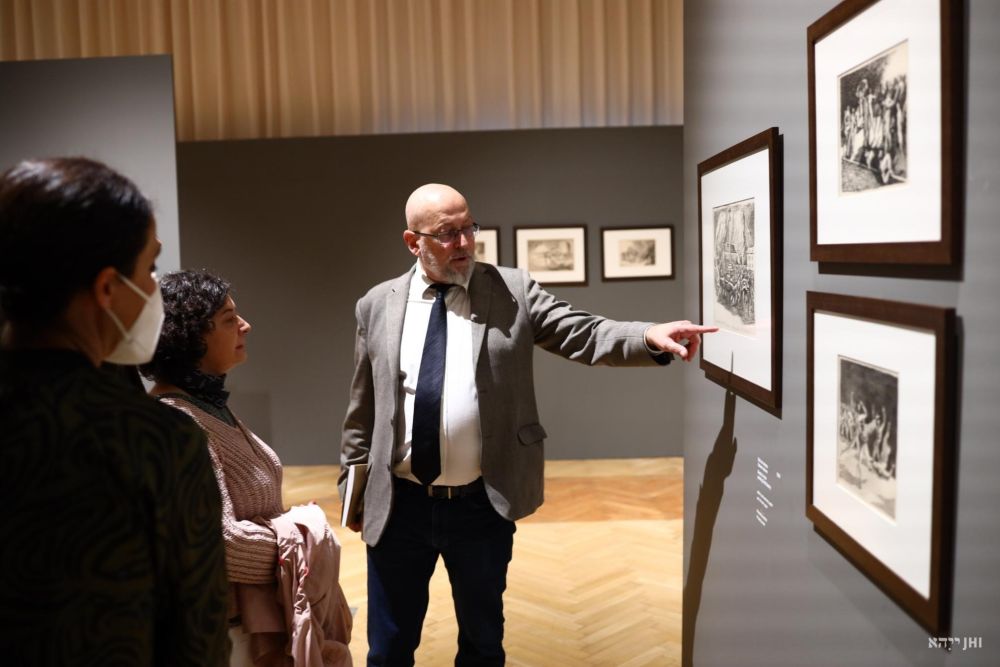- News
- Events
- Oneg Shabbat
- Collections
- Research
- Exhibitions
- Education
- Publishing Department
- Genealogy
- About the Institute
- Bookstore

%20(6).jpg)
The event was attended by representatives of the diplomatic corps, cultural institutions, and the Jewish community, as well as colleagues and friends of the Jewish Historical Institute.
‘The exhibition is a harrowing document of the war, which has a special impact on us today,’ said the director of the Jewish Historical Institute, Monika Krawczyk.
‘Wejman’s prints are one of only two or three sets of works of this kind by one artist, created in the years 1940-1944 in occupied Warsaw. It can only be compared with the works of Władysław Strzemiński and Felicjan Kowarski of the same rank. It is said that inter arma silent Musae, however Wejman also worked during the war, war that destroys art and paper. The artist suffered from a shortage of paper, so he tried etching, which he had never done before. I also assume that he hoped that the metal matrix would have a better chance of surviving if there was a fire – said the exhibition’s curator, Dr. Piotr Rypson.
Monika Krawczyk, Stanisław Wejman, Piotr Rypson / guests at the temporary exhibition “Dancers 1944. Mieczysław Wejman”. Photos by Grzegorz Kwolek (JHI)
‘Dancers dance in the fire of war. During the occupation, Wejman not only created, but also took part in conspiratorial exhibitions. At the end of 1943, a conflict with a Volksdeutsch [Pole with German roots who became a German collaborator – ed.], manager of his workplace, forced him to hide from the Germans. It was then that a series of nearly 40 works that we present at the exhibition was created. This series has never been shown in full splendor before – added Rypson.
‘The language of Wejman’s art has always been very metaphorical and the etchings are difficult to interpret. They show people who became victims, who were forced to undress and dance. A clear line separates them from those who are just watching, they are observers, accomplices.
‘It is a mistake to try to translate the language of images into the language of words – said Stanisław Wejman, graphic artist and painter, professor of fine arts, the artist’s son. – I spent many years with the creator of these works, but I do not always understand the language of this dance, which shows moments of truth and extreme events. In the face of today’s events in the East, looking at these works we experience déjà vu.
‘During the years of the occupation, my father considered himself a student. He was tutored by professor Mieczysław Kotarbiński, who was murdered by the Germans. During the Warsaw Uprising, the house where he worked was destroyed, many drawings were lost and my father perhaps didn’t know exactly how many of them there were.
‘The language of Dancers relates to the Italian commedia dell'arte. The series was also supposed to belong to the diploma thesis under the general title Zabawa ludowa [Folk Revelry]. My father thought about it for most of his life since the Warsaw Ghetto Uprising in the spring of 1943, when terrible things were happening. The Germans built an amusement park next to the ghetto wall. Loud music was played, people could dance, there were high poles that boys climbed on to take a sausage or a drink. The Germans created it to blur reality and create a double image, to send this image into the world, which was to convince everyone that Poles, citizens of the capital, are pleasantly satisfied with what is happening in the ghetto, added Stanisław Wejman.
_____
‘The artist’s works in the years 1943–1944, between the July 1942 “Gross Aktion” (Great Action or Operation, namely the deportation and mass murder of Jews from the Jewish quarter), the Ghetto Uprising (April 1943) and the outbreak of the Warsaw Uprising (August 1st 1944) became one of the most important Polish artistic documents recording the German occupation – especially the Holocaust,’ writes Dr. Piotr Rypson, curator of the temporary exhibition “Dancers 1944. Mieczysław Wejman”.
The exhibition presents wartime graphics and sketches by Mieczysław Wejman (1912-1997), painter, graphic artist, rector of the Academy of Fine Arts in Kraków, co-founder of the International Print Biennial in Kraków.
You’re welcome to see the exhibition until October 13. Entrance is free of charge!
__
Supported by the Norway and EEA Grants from Iceland, Liechtenstein and Norway and the national budget
![norweskie_belka_EN_od_11.2021.jpg [347.29 KB]](https://www.jhi.pl/storage/image/core_files/2022/5/26/728739c11fac2ac0888ece903ada7662/jpg/jhi/preview/norweskie_belka_EN_od_11.2021.jpg)